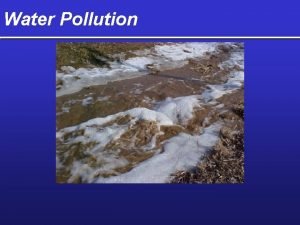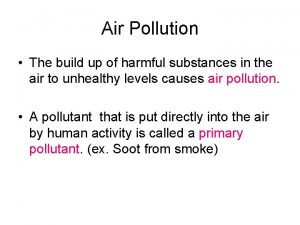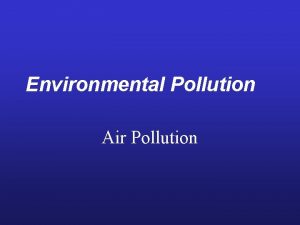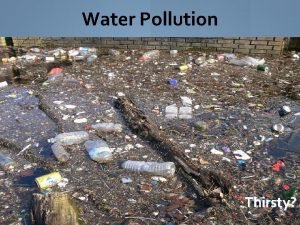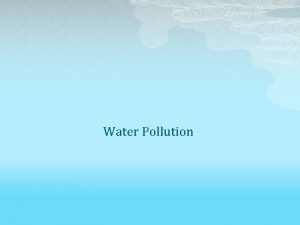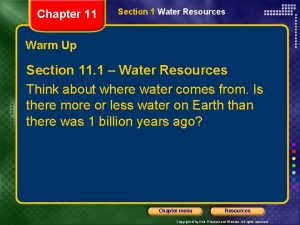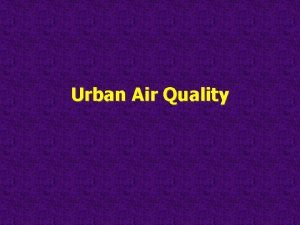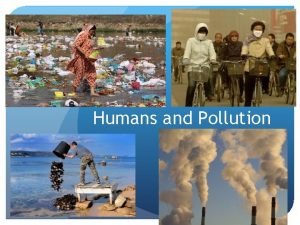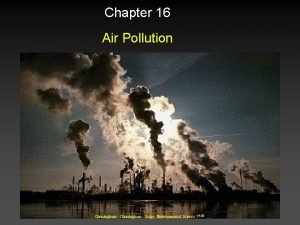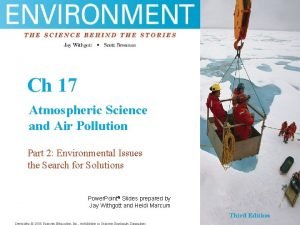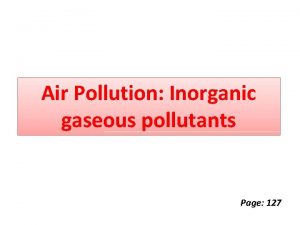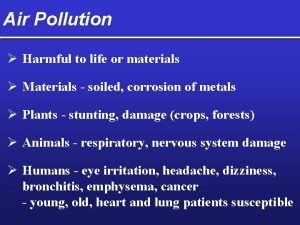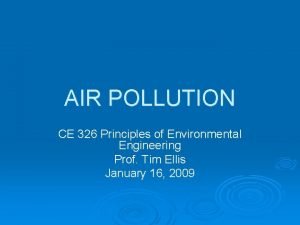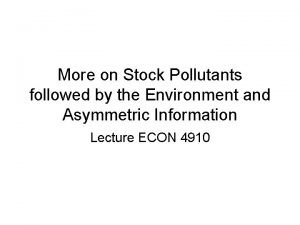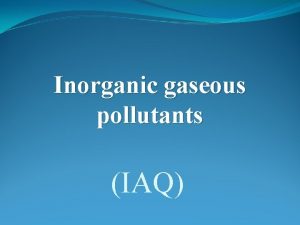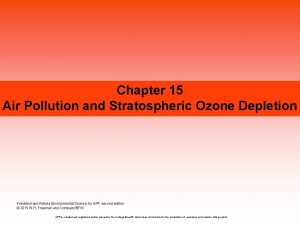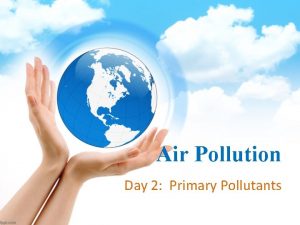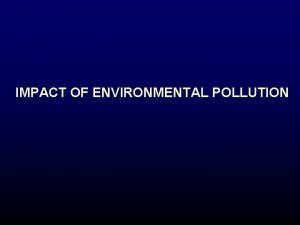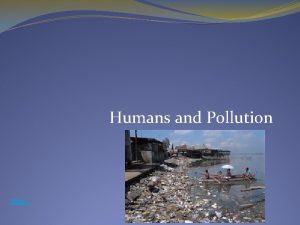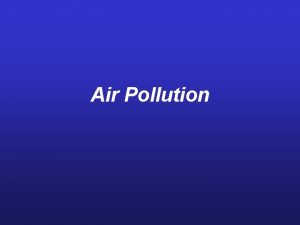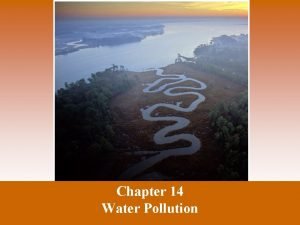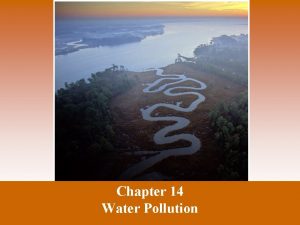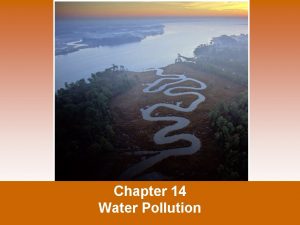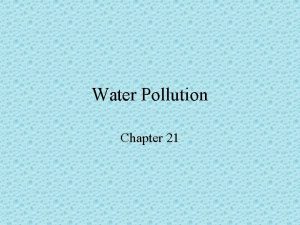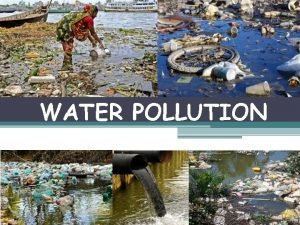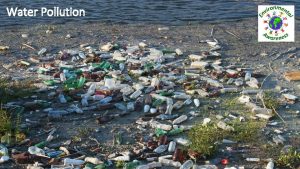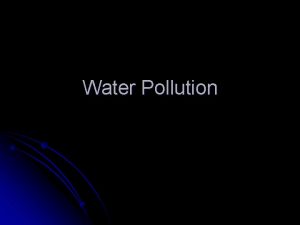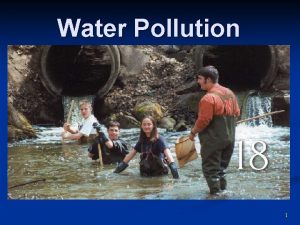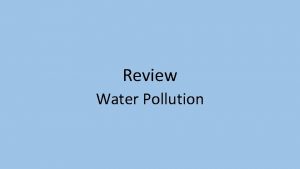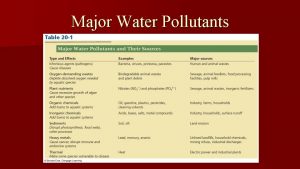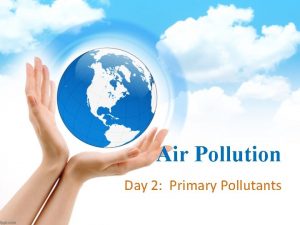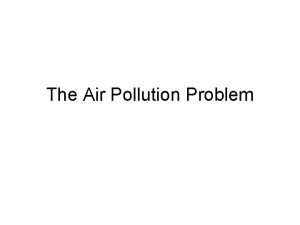Water Pollution Chapter 14 Major Types of Pollutants




















- Slides: 20

Water Pollution Chapter 14 Major Types of Pollutants 1) Infectious Agents (bacteria, parasites) - sources = human/animal wastes - effects = diseases 2) Oxygen-Demanding Wastes (bacteria-creating wastes) - sources = sewage, livestock, paper/food plants - effects = lowers dissolved oxygen in water habitats 3) Inorganic Chemicals (acids, metals, salts) - sources = industry, homes - effects = harms organ systems of organisms

4) Organic Chemicals (fossil fuels, pesticides) - sources = industry, homes, farms - effects = harms organ systems of organisms 5) Plant Nutrients (nitrates, phosphates) - sources = sewage, farms, lawns - effects = lowers dissolved oxygen in aquatic habitats 6) Sediment (silt) - sources = erosion - effects = clog streams, reduce clarity & photosynthesis 7) Radioactive Wastes (radon, uranium) - sources = nuclear plants, mining - effects = cancers, mutations, birth defects

8) Heat (thermal pollution) - sources = power plants, industry - effects = lowers DO, abrupt temp. changes

Measuring Water Quality - accomplished by looking at: 1) Fecal Coliform Bacteria - causes many diseases - drinking water = 0 coliform - swimming water = 200 colonies/100 ml 2) Dissolved Oxygen (DO) - indicates presence of excess nutrients - can measure DO or biological oxygen demand (BOD) 3) Chemical Analysis - identifies organic & inorganic chemicals 4) Indicator Species - analyzing health of organisms

Water Quality DO (ppm) at 20˚C Good 8 -9 Slightly polluted 6. 7 -8 Moderately polluted Heavily polluted Gravely polluted 4. 5 -6. 7 Below 4. 5 Below 4

NONPOINT SOURCES Rural homes Cropland Urban streets Animal feedlot Suburban development POINT SOURCES Factory Wastewater treatment plant Point & Nonpoint Source Pollutants

Types of organisms Normal clean water organisms (trout, perch, bass, mayfly, stonefly) Trash fish (carp, gar, leeches) Fish absent, fungi, sludge worms, bacteria (anaerobic) Trash fish (carp, gar, leeches) Normal clean water organisms (trout, perch, bass, mayfly, stonefly) 8 ppm Dissolved 8 ppm oxygen (ppm) Biological oxygen demand Clean Zone Septic Zone Clean Zone Recovery Zone Decomposition Zone Stream Pollution & Recovery occurs if: 1) no pollution overload 2) no reduced stream flow

Lake Pollution - 2 main concerns: 1) Biological Magnification - build-up of fat-soluble chemicals at higher trophic levels in a food web - examples: DDT, PCB’s, mercury 2) Eutrophication - lowering of DO due to increase of nutrients causing excessive algae growth, leading to excessive algae death, increasing aerobic decomposers

Biological Magnification Water 0. 000002 ppm Phytoplankton 0. 0025 ppm Herring gull 124 ppm Herring gull eggs 124 ppm Zooplankton 0. 123 ppm Lake trout 4. 83 ppm Rainbow smelt 1. 04 ppm


Discharge of untreated municipal sewage (nitrates and phosphates) Nitrogen compounds produced by cars and factories Discharge of detergents ( phosphates) Natural runoff (nitrates and phosphates Inorganic fertilizer runoff (nitrates and phosphates) Manure runoff from feedlots (nitrates, phosphates, ammonia) Discharge of treated municipal sewage (primary and secondary treatment: nitrates and phosphates) Lake ecosystem nutrient overload and breakdown of chemical cycling Runoff from streets, lawns, and construction lots (nitrates and phosphates) Dissolving of nitrogen oxides (from internal combustion engines and furnaces) Sources of Eutrophication Nutrients Runoff and erosion (from cultivation, mining, construction, and poor land use)

Groundwater Pollution - sources include: - waste lagoons, septic tanks, landfills, hazardous waste dumps, deep injection wells - chemicals causing health issues are: - petrochemicals, organic solvents, pesticides, arsenic, lead - more easily contaminated because: 1) slow movement of water 2) less decomposing bacteria 3) colder temperatures

Polluted air Groundwater Pollution Coal strip mine runoff Hazardous waste injection well Pesticides and fertilizers De-icing road salt Pumping well Buried gasoline and solvent tank Cesspool septic tank Gasoline station Water pumping well Waste lagoon Landfill Sewer Leakage from faulty casing Accidental spills ter a shw ifer u q ra re df e n i f n nco U df e n nfi Co ate hw res ifer u aq Discharge Confined aquifer Groundwater flow

Solutions Groundwater Pollution Prevention Find substitutes for toxic chemicals Cleanup Pump to surface, clean, and return to aquifer Install monitoring wells Require leak detectors on underground tanks Inject microorganisms to clean up contamination Ban hazardous waste disposal in landfills and injection wells Store harmful liquids in aboveground tanks with leak detection Pump nanoparticles of inorganic compounds to remove pollutants

Ocean Pollution Industry. Urban sprawl Construction sites Farms Cities Red tides Closed beach Closed shellfish beds Oxygen-depleted zone Toxic sediments Healthy zone Oxygen-depleted zone

Solutions Coastal Water Pollution Prevention Cleanup Ban dumping of wastes by ships in coastal waters Improve oil-spill cleanup capabilities Ban ocean dumping of sludge Sprinkle nanoparticles over an oil spill to dissolve the oil Protect sensitive areas Regulate coastal development Recycle used oil Require double hulls for oil tankers Require treatment of coastal sewage

Surface Water Solutions - nonpoint source: 1) reduce fertilizer use 2) plant buffer zones 3) reduce pesticide use 4) preserve riparian zones 5) practice soil conservation - point source: 1) Legislation - Clean Water Act, Water Quality Act, Safe Drinking Water Act 2) Technology - septic tanks - sewage treatment plants

Septic tank with manhole (for cleanout) Household wastewater Nonperforated pipe Distribution box (optional) Gravel or crushed stone Drain field Vent pipe Perforated pipe Septic Tank

Sewage Treatment Secondary Primary Bar screen Grit chamber Settling tank Aeration tank Settling tank Chlorine disinfection tank To river, lake, or ocean Raw sewage from sewers Sludge (kills bacteria) Activated sludge Air pump Sludge digester Sludge drying bed Disposed of in landfill or ocean or applied to cropland, pasture, or rangeland

Solutions Water Pollution • Prevent groundwater contamination • Reduce nonpoint runoff • Reuse treated wastewater for irrigation • Find substitutes for toxic pollutants • Practice four R's of resource use • Reduce resource waste • Reduce air pollution • Reduce poverty • Reduce birth rates
 Primary pollutants and secondary pollutants
Primary pollutants and secondary pollutants Primary pollutants and secondary pollutants
Primary pollutants and secondary pollutants What is a primary air pollutant
What is a primary air pollutant Major air pollutants
Major air pollutants Water and water and water water
Water and water and water water Examples of point source pollution
Examples of point source pollution Types of water pollution
Types of water pollution Introduction water pollution
Introduction water pollution Chapter 11 section 3 water pollution answer key
Chapter 11 section 3 water pollution answer key Secondary pollutants examples
Secondary pollutants examples Primary and secondary pollutants
Primary and secondary pollutants Primary vs secondary pollution
Primary vs secondary pollution Copyright
Copyright Inorganic gaseous pollutants of air
Inorganic gaseous pollutants of air Secondary air pollutants
Secondary air pollutants Primary vs secondary pollutants
Primary vs secondary pollutants Stock pollutants
Stock pollutants Inorganic gaseous pollutants of air
Inorganic gaseous pollutants of air Primary and secondary pollutants difference
Primary and secondary pollutants difference What are the secondary air pollutants
What are the secondary air pollutants Pollution definition
Pollution definition
